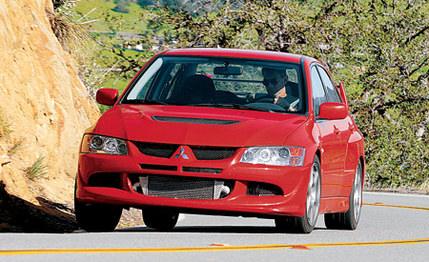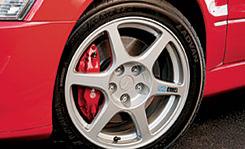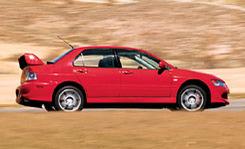 Long-Term Road Test
Long-Term Road Test
When Mitsubishi sent us a Lancer Evolution for a long-term test back in March 2003, the carmaker hadn't yet fallen into its Ty-D-Bol man impersonation that the company found itself doing for most of 2004. Last year was not a good year for Mitsubishi, but the Evo continues to be the one must-have product in the lackluster lineup. The vehicles that launched just before and after the Evo (the Endeavor and the new Galant) didn't buoy the brand; instead, they pulled sales into the lav and toward the porcelain.
Sales of the Evo cannot be blamed for Mitsubishi's current problems. The car might not sell in large numbers, but its performance and purity give us, and others, a reason to hope that Mitsu can find a way out of its troubles. We still feel the same way about the car even after almost two years and 40,000 miles, but aside from amusing us, our Rally Red stormer also bemused (and, as you'll see, abused) us, but it certainly never bored us.
For the first 600 miles, we treated the Evo like a cute baby lamb. That's because Mitsubishi tells us the break-in is a crucial time in an Evo's life. If you're kind for those first miles, you will be rewarded with quicker acceleration, and it will never burn oil, Mitsubishi claims.
Less than a month later, we tested the Evo, and our self-control was repaid with a 0-to-60 time of 5.0 seconds. Forty-thousand miles later, the repeat performance took 5.1 seconds. Also, we never had to add a quart of oil over all those miles. We've heard from owners who couldn't keep from cranking the tach to the far right as they pulled out of the showroom lot and now must add quarts of oil regularly.
By early summer, the Evo logbook began to fill with love letters. Online editor Kiino reveled in the lack of turbo lag, excellent gearbox, perfect pedal position, and supportive, race-inspired Recaro seats. When the Evo was young, Kiino's comments received boisterous hallelujahs and amens from the rest of the C/D flock. But later, we would find much to gripe about.
The first complaints were aimed at the quick (2.1 turns lock-to-lock) steering that was praised for its feel and accuracy but just as often derided for a level of nervousness usually reserved for amphetamine aficionados. Not helping matters was an unyielding suspension that didn't know how to relax. As one editor put it, "The Evo feels as if the axles were welded to the body." We checked. They're not. The 2005 MR version of the Evo goes a long way toward calming the suspension, but our 2003 model didn't have the magic Bilstein shocks, so we were a bit abused.
 With such a harsh suspension, many began to feel as if they'd joined a cult of flagellants. So it should come as no surprise that the Evo rarely ventured beyond the borders of our mitten-shaped state. With a cache of more luxurious vehicles in the long-term fleet, the Mitsu found itself staying in, parked on the couch in its underwear. For the more adventurous among us who braved the ride and didn't mind the lack of cruise control, the Evo proved to be a willing weekend companion. Long trips revealed the excellence of the Recaro seats and the car's brilliant passing power and bright xenon headlights that make it a great horizon chaser. The only problem was the view out the rear window. The gaudy, optional carbon-fiber spoiler ($480) attached to the trunk is set exactly in the line of sight of the rearview mirror. It's important to check your six for the occasional Smokey, especially if you don't have cruise control. The wing effectively hides the identity of the cars behind it like a black bar over the eyes. Didn't anyone see this problem in the prototype stage? We were bemused.
With such a harsh suspension, many began to feel as if they'd joined a cult of flagellants. So it should come as no surprise that the Evo rarely ventured beyond the borders of our mitten-shaped state. With a cache of more luxurious vehicles in the long-term fleet, the Mitsu found itself staying in, parked on the couch in its underwear. For the more adventurous among us who braved the ride and didn't mind the lack of cruise control, the Evo proved to be a willing weekend companion. Long trips revealed the excellence of the Recaro seats and the car's brilliant passing power and bright xenon headlights that make it a great horizon chaser. The only problem was the view out the rear window. The gaudy, optional carbon-fiber spoiler ($480) attached to the trunk is set exactly in the line of sight of the rearview mirror. It's important to check your six for the occasional Smokey, especially if you don't have cruise control. The wing effectively hides the identity of the cars behind it like a black bar over the eyes. Didn't anyone see this problem in the prototype stage? We were bemused.
Another problem is that the Evo makes anyone who drives it look like the sort who is first in line at the mall for those hot Vin Diesel autograph sessions, guys whose bedroom walls are pasted with The Fast and the Furious posters. The exterior design of this boy racer even embarrassed one of our 20-year-old staffers. That pretty much explains why the older-than-35 crowd here wasn't in a hurry to sign it out.
 Mitsubishi's service schedule calls for a change of the synthetic oil and a tire rotation every 5000 miles. Although the price varied, these usually cost about $100 ($25 for the rotation and $75 for the oil change). In addition to the oil change, the Evo requires several inspections at 15,000 miles. That stop totaled $200. At 30,000 miles, just about every fluid used in the car had to be replaced, setting us back $564. The brake pads had been eaten up by 30,000 miles, and replacing them cost $907. You'd think having to put up that kind of bread would get you an invitation from the service manager for a fishing weekend on his bass boat. No such luck.
Mitsubishi's service schedule calls for a change of the synthetic oil and a tire rotation every 5000 miles. Although the price varied, these usually cost about $100 ($25 for the rotation and $75 for the oil change). In addition to the oil change, the Evo requires several inspections at 15,000 miles. That stop totaled $200. At 30,000 miles, just about every fluid used in the car had to be replaced, setting us back $564. The brake pads had been eaten up by 30,000 miles, and replacing them cost $907. You'd think having to put up that kind of bread would get you an invitation from the service manager for a fishing weekend on his bass boat. No such luck.
Our Mitsu spent three months in the hospital after being broadsided by a poorly driven Nissan Altima. The driver of the Altima claimed innocence, but a cop was parked nearby, eyeballing activity at the intersection, and just happened to tape the whole accident.
It was nearly the summer of 2004 when our reconstructed Evo got out of intensive care. Almost immediately we noticed a grinding whenever we'd shift into fifth gear. At the 25,000-mile service, the masterminds at Moran Mitsubishi in Southfield, Michigan, were unable to reproduce the grinding and sent us on our— crunch!—way. The logbook began to fill with entries complaining about how tired and worn out the Evo felt. This crunching continued for another 15,000 miles, until the end of the test, when the second- and fifth-gear synchros (shifting into second had become difficult) were finally replaced under warranty. While the transmission was being rebuilt, we opted to have the clutch replaced because it had slipped away into the ether. Although a new clutch usually runs about $1500 for parts and labor, in this case we only had to pay $741 for parts. And by the end of its time here, the Evo's front brake rotors were warped and were also replaced under warranty. See what we mean about tired? The total cost for the 40K service and repairs set us back $829. Word got around that the service manager traded in his bass boat for a new yacht. You'd think he'd invite us to party on it. He didn't.
So after 17 months of hammering this hot rod, what did we learn? We learned that our Evo is often as high-strung as it looks. Some of us were turned off by its unrefined raw temperament, but those who loved the Evo tended to view the rawness as purity. Our 40,000 miles showed that the price of replacing the Evo's track-ready parts isn't cheap, but as long as a $30,000 sedan with this level of performance exists, the world will be a better place. And hey, don't get the spoiler. Last of all, we hope Mitsubishi finds a way to get some of the Evo's polarizing passion into the rest of the lineup before it's too late.